Lea Wait's Blog, page 26
November 19, 2024
When to End a Series by Matt Cost
Mainely Mayhem pubbed on November 13th. Less then one week ago. It is the 6th book in my Mainely Mystery Mysteries. And I wonder about doing something I have never done before. Ending a series.
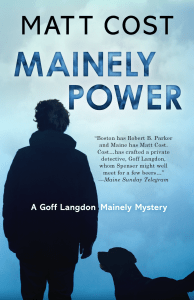
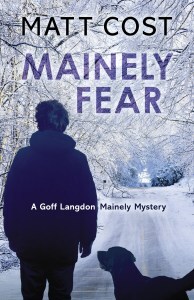
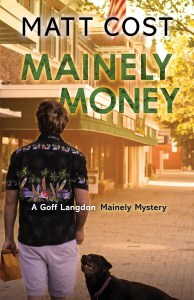
This is new terrain for me, and I am not sure I am up to the task. Goff Langdon, Chabal, Missouri, Richam, Jewell, Bart, Jimmy 4 by Four, and others have become family to me. At the beginning, I thought that six books were a good number to shoot for. Now? I have my doubts.
Mayhem finds Langdon delving into the background of a potential nominee to the Supreme Court of the United States. A man with some shenanigans in his past that Langdon questions whether they are more than a young man pulling harmless pranks or a pattern of abuse that might delve into far more harmful behavior. But before Langdon can dig any deeper, the White House pulls him from the investigation and moves the process forward. Why?
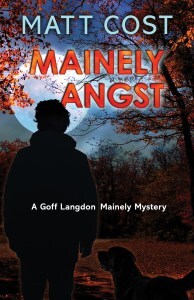
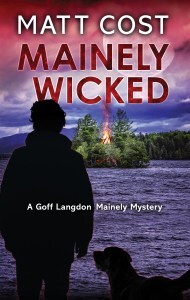
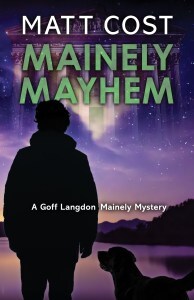
Like a, his dog, with a bone, Langdon cannot let it go. Many hijinks ensue. The plot twists like a Frosty’s donut (that’s a Brunswick reference for those of you not in the know). But in the end, there is a line that ties the first five books together with this one. As I wrote it, completing the book, I just stared at the screen for a long minute. Was this it? Was it over?
I have been tussling with this since writing that last line a year ago. There have been some other projects in the works. I have started two new series. A modern-day Robin Hood story where Max Creed fights for justice on behalf of those wronged by the ultra-wealthy. And a historical PI mystery with Jazz Jones and January Queen set in 1950s Raleigh with significant Civil Rights connotations.
One thing in Langdon’s favor is he still has growth to do. I think? These are mysteries by the book, but really, about the characters arc of growth by the series. To continue the series, something must be shook up or shaken out. Langdon needs to… do what? This is something to be pondered.
Mainely Mayhem was great fun to write and that is a signal that the series should continue. Or is it a sign that it is time to stop? There is plenty of mystery left to be had in Brunswick. Murder She Wrote, Jessica Fletcher, in Cabot Cover, Maine, had 264 episodes. I imagine that there are a few more crimes to be committed, murders pending, and misbehavior to be had in Brunswick.
What say you, readers and writers? When should a series end? Should we wave goodbye to Langdon and his colorful group of family and friends?
About the Author
Matt Cost was a history major at Trinity College. He owned a mystery bookstore, a video store, and a gym, before serving a ten-year sentence as a junior high school teacher. In 2014 he was released and began writing. And that’s what he does. He writes histories and mysteries.
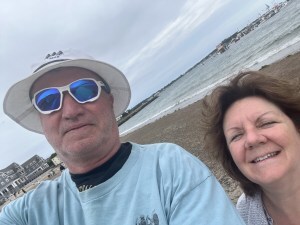
Cost has published six books in the Mainely Mystery series. He has also published five books in the Clay Wolfe Trap series.
For historical novels, Cost has published At Every Hazard and its sequel, Love in a Time of Hate, as well as I am Cuba. In April of 2023, Cost combined his love of histories and mysteries into a historical PI series set in the 1920s, the Brooklyn 8 Ballo series.
Cost now lives in Brunswick, Maine, with his wife, Harper. There are four grown children: Brittany, Pearson, Miranda, and Ryan. They have been replaced in the home with four dogs. Cost now spends his days at the computer, writing.
November 17, 2024
Finding the Right Place to Start the Story
Kaitlyn Dunnett/Kathy Lynn Emerson here, finally actually (amazingly!) doing some new writing. Of course it’s revising an old book, but still . . .
Back in the 1990s, after writing two books for the Harper Monogram romance line, I signed a contract to write two more. I had a great deal of the plot worked out for one of these books. Naturally, they wanted the other one first . . . and they wanted it in three months.
 In those days, if you were lucky enough to be offered an advance for a novel on the basis of a proposal, you didn’t argue about deadlines. 100,000 words in twelve weeks was do-able. Whether or not they were particularly well-written words is another matter.
In those days, if you were lucky enough to be offered an advance for a novel on the basis of a proposal, you didn’t argue about deadlines. 100,000 words in twelve weeks was do-able. Whether or not they were particularly well-written words is another matter.
I had a splitting stress headache for the entire three months. It vanished the day I finished the book. When the editor accepted the manuscript without asking for a lot of revisions—her main concern, since this was a historical romance, was that the characters were separated for long stretches of text—I gladly took her word for it that the story held together.
Fast forward to my semi-retirement and decision to revise and re-release backlist titles. I soon discovered that most of the romance novels I’d written, both contemporary and historical, were sadly flawed. Fixable, but flawed. The worst of the worst was this one. There were plot holes big enough to drive a semi through, and only some of them were related to the fact that my heroine, a seventeenth-century woman in Colonial New England, was cursed with paranormal abilities. She experiences visions when she encounters scenes where violence took place. Worse, the victims of that violence talk to her afterward. In those days, that was enough to get you accused of practicing sorcery.
I’ve been putting off tackling this rewrite for months, but the other day I took a fresh look at it and at the notes I made for revisions. My goal is to focus on the heroine’s story as opposed to her relationship with the hero. To do that, I need to start the story not when they meet, but when she first comes into her powers as a child. Hence new chapters up front. A new place to begin the book.
Here’s how the original version opened:
London, 1632
Pain circled his eyes. The back of James Mainwaring’s head throbbed, and he wondered what giant’s manacled fist was clenched so hard around the scruff of his neck. All his teeth ached.

our hero, from the back cover of the original
For a long moment Jamie lay perfectly still, unwilling to risk the agony movement was certain to bring. He was equally reluctant to lift his eyelids, but even without sight he began to gain a sense of his present surroundings.
He knew he was lying on his stomach, naked, his head turned to the right, in a strange bed in a strange chamber. He was very sure that he was not in his own lodgings in Coney’s Court. This was not his fine, soft featherbed.
The thin, uneven, prickly surface beneath him was a bed tick stuffed with damp, moldering straw. The musty smell was not quite strong enough to make him nauseous but more than sufficient to discourage him from taking too many deep breaths.
Gradually another scent began to tantalize him, one that was faint but pleasant. His sluggish mind struggled to identify it through a haze of fuzziness and pain. Rose water. At almost the same moment that he reached that conclusion Jamie became aware that his right hand was resting not on lumpy bedding but on flesh. His slack fingers were loosely curved around the unmistakably feminine swell of a breast.

Focus on hero. Focus on sex. Historical romance cute-meet, or meet cute, if you go by the dialogue in The Holiday. I always heard it the first way in the romance writing community, before I saw that movie, but I digress.
Here’s the new beginning, set years earlier and in the point of view of the heroine’s horrified mother:
London, August 1623
“Mama,” Ellen Allyn said in a plaintive voice. “The dead girl followed us home.”

I don’t know if this will stay the opening line. I don’t even know if this book can be revised into a novel people will want to read. It’s early days yet, with lots of revising left do do, but I already know that I prefer a timeline that doesn’t jump around. Flashbacks and dream sequences (not to be confused with Ellen’s visions) and long conversations with other characters about past events slow down the pacing. Besides, I want my readers to understand and sympathize with Ellen from the beginning. I doubt meeting her for the first time in the bed of a stranger achieved that goal.
Incidentally, although this isn’t a mystery, Jamie is on a quest. He’s searching for the lost city of Norumbega and has to follow clues, with Ellen’s help, to find it in the wilds of what is now the State of Maine. There are a couple of crimes along the way, too, and personal danger for Ellen because although today she’d simply be regarded as someone with a “gift” (or at the worst, as an eccentric who thinks she sees the past), in the 1600s she comes perilously close to being tried as a witch.
So, that’s what I’m up to these days. I’d love to hear reactions from readers of this blog. How do you feel about novels with flashbacks? Do you read paranormal stories? Does it turn you off when a novel starts during the childhood of the main character? Any and all comments are welcome.

Kathy Lynn Emerson/Kaitlyn Dunnett has had sixty-four books traditionally published and has self published others. She won the Agatha Award and was an Anthony and Macavity finalist for best mystery nonfiction of 2008 for How to Write Killer Historical Mysteries and was an Agatha Award finalist in 2015 in the best mystery short story category. In 2023 she won the Lea Wait Award for “excellence and achievement” from the Maine Writers and Publishers Alliance. She was the Malice Domestic Guest of Honor in 2014. She is currently working on creating new editions of her backlist titles. Her website is www.KathyLynnEmerson.com.
November 15, 2024
Weekend Update: November 16-17, 2024
 Next week at Maine Crime Writers there will be posts by Kaitlyn Dunnett/Kathy Lynn Emerson (Monday), Matt Cost (Tuesday), Maureen Milliken (Thursday), and Sandra Neily (Friday).
Next week at Maine Crime Writers there will be posts by Kaitlyn Dunnett/Kathy Lynn Emerson (Monday), Matt Cost (Tuesday), Maureen Milliken (Thursday), and Sandra Neily (Friday).
In the news department, here’s what’s happening with some of us who blog regularly at Maine Crime Writers:
Matt Cost will be signing copies of his just pubbed Mainely Mayhem at Sherman’s Maine Coast Book Shop festival in Topsham today, Saturday November 16th, from 1-4 p.m.
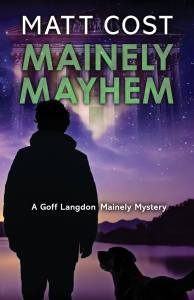
An invitation to readers of this blog: Do you have news relating to Maine, Crime, or Writing? We’d love to hear from you. Just comment below to share.
And a reminder: If your library, school, or organization is looking for a speaker, we are often available to talk about the writing process, research, where we get our ideas, and other mysteries of the business, along with the very popular “Making a Mystery” with audience participation, and “Casting Call: How We Staff Our Mysteries.” We also do programs on Zoom. Contact Kate Flora
November 14, 2024
Publishing is Murder
Rob Kelley here, talking this last weekend with my crime writing colleagues about the increasingly chaotic world of publishing. Last weekend was our beloved New England Crime Bake.  The sessions featured new authors, experienced authors, and legends, talking about craft, characterization, and cheering on authors and soon-to-be-authors alike. I wrote this summer about the joys of writing conferences and the spirit of camaraderie and joy they give me as a writer, and that was certainly true this weekend.
The sessions featured new authors, experienced authors, and legends, talking about craft, characterization, and cheering on authors and soon-to-be-authors alike. I wrote this summer about the joys of writing conferences and the spirit of camaraderie and joy they give me as a writer, and that was certainly true this weekend.
We all had a great time sharing our love for books and the genre, but all of the writers in the room share something else as well: a recognition of the fundamental–and accelerating–changes in the publishing world. What has been true for parts of the publishing world is now true for all of it: the old model of finding an agent, them finding you a publisher, and settling in for a mostly stable career with your partners has absolutely vanished.
Over drinks on Saturday night a large number of us talked about our own experiences with self-publishing, hybrid publishing (partnering with a publisher but bearing more of the financial cost for a higher return on sales), small press publishing, and larger press publishing, recognizing that all of it is in flux.
A colleague has just taken back ownership of copyright of her first three books in a series, done new covers, fired up her own press and published them and a fourth with solid success. Another just moved from one small press to another, worried about the first press’s financial status as they work hard to produce really good books but suffer from a lack of business savvy that might jeopardize all of their authors. In contrast, another friend just learned that their path to publication is now in limbo with the resignation of the editor they had been working with, but felt relieved that at least they still own their copyright and can try again.
A downright famous author I know made a decision to move to a press with a more integrated media strategy that should result in better TV and movie opportunities. Another writer who had strong interest from agents for a debut, pulled their book after a hybrid publisher reached out and tempted them into that world. Then, of course, there are the as-yet-unpublished authors who are listening to this chaos and wondering if there will ever be a place for their fine work.
There are more books published every year, which should be good news for writers, as the market is expanding. On the other hand there were some very concerning and confusing stats coming out of the suit against Penguin Random House by the Department of Justice a couple of years back that showed that 90% of books sell fewer than 2,000 copies (there are a ton of other stats from that suit, but it gets confusing, as individual ISBNs for print, audio, etc. are sometimes used in the statistics).
So, should that bum us out? Well, if you are self-published and sell 2000 copies of your debut novel, I think you’d be pretty darn happy. Because here’s the challenge we all–novice to NYT best seller–now face. We need to do the math, understand the business part of being an author, and decide for each and every book what our best move is.
Got an agent who gets you a pretty good advance at one of the Big 5 (Penguin Random House, Simon & Schuster, Hachette, HarperCollins, and Pan Macmillan) who own over 80% of the trade book market in the US? Sounds like the dream we’d all have for our debut novel. But if you launch amid a crowded list, don’t get much publicity help, and don’t earn out your advance, your next book is going to be a slog to sell.
On the other hand, you go with a hybrid press, putting some of your money for production up front, getting help from that press with publicity, maybe keeping all of your own audio rights and using Amazon’s ACX to split your audio proceeds with the voice artist, then getting a much higher percentage of audio, e-book, and print book sales than you would at the Big 5, you might really crush it. Of course, that’s more complicated.
Or you self-publish, through Amazon or Ingram Spark, you’ll have to do it all yourself or pay someone to do it, but then you get all of the proceeds.
Which one is lower risk, higher return? Which one is right for you? Maybe any one of them. Maybe multiple versions, some of your books self-published, some hybrid, some traditional. With options come decisions, big ones, like: if I am hustling on social media and touring libraries, when do I have time to write? Or, do I spend time learning to build a website or pay someone to do it?
Here’s what is a right answer now: paying attention to the changing market so that you can make smart decisions about getting your book into the hands of the readers you desire, whether that’s 500 dedicated souls who anxiously await your next title or 500,000 general interest readers who might stumble across your book. No wrong answer, just a lot of potentially right ones.
November 12, 2024
They Also Served
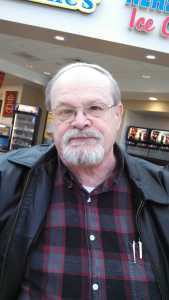
Vaughn C. Hardacker
As commandant of the Meo Bosse Detachment 1414 Marine Corps League, I received a request from a friend for a Marine Corps presence at her husband’s funeral on Saturday, July 13, 2024. She asked if we could be present at the interment at the cemetery. My reply was that we would not only attend but also provide an honor guard, present a flag, and perform a rifle salute. Her husband was a member of our detachment and, after six years of service with the USMC, served over twenty years with the Maine State Police. She told me that the Maine State Police were also having a flag ceremony and presenting one to her. She said, “If you can also give one, I will pass them on—one to each of my two sons.
The ceremony went off like clockwork.
There are many ways to describe the Armed Forces of The United States. At a recent VFW meeting, another veteran told me what the differences between them are: “The Army and Navy are services; the Air Force is a corporation; but, you Marines are a cult.” I replied, “You’re right … and we’re damned proud of it.”
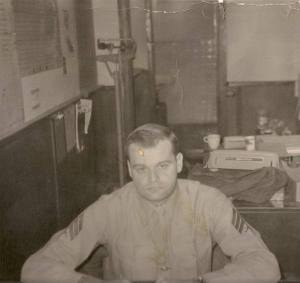
Sgt. Vaughn C. Hardacker, USMC, Iwakuni, Japan 1973
I returned home from the funeral and received the email below. After reading it, I knew I had to share this… it should actually apply to all veterans. (Don’t be surprised if I share it again on Veterans’ Day.)

Emblem of The United States Marine Corps
I received this from a fellow Marine Brother and have no recourse but to share it.
“Cemetery Watchman”
My friend Kevin and I volunteer at a National cemetery in Oklahoma, and we put in a few days a month in a ‘slightly larger’ uniform. Today had been a long, long day, and I just wanted to get the day over with and go down to Smokey’s for a cold one. Sneaking a look at my watch, I saw the time: 16:55. Five minutes to go before the cemetery gates are closed for the day.
Full dress was hot in the August sun. Oklahoma summertime was as bad as ever, with heat and humidity at the same level—both too high.
I saw the car pull into the drive, ’69 or ’70 model Cadillac Deville, looked factory-new. It pulled into the parking lot at a snail’s pace. An old woman got out so slow I thought she was paralyzed; she had a cane and a sheaf of flowers–about 4 or 5 bunches as best I could tell.
I couldn’t help myself. The thought came unwanted, and left a slightly bitter taste: ‘She’s going to spend an hour, and for this old soldier, my hip hurts like hell and I’m ready to get out of here right now!’ But for this day, my duty was to assist anyone coming in.
Kevin would lock the ‘In’ gate and if I could hurry the old lady along, we might make it to Smokey’s in time.
I broke post attention. My hip made gritty noises when I took the first step and the pain went up a notch. I must have made a real military sight: middle-aged man with a small pot gut and half a limp, in marine full-dress uniform, which had lost its razor crease about thirty minutes after I began the watch at the cemetery.
I stopped in front of her halfway up the walk. She looked up at me with an old woman’s squint.
‘Ma’am, may I assist you in any way?
She took long enough to answer.
‘Yes, son. Can you carry these flowers? I seem to be moving a tad slow these days.
‘My pleasure, ma’am.’ (Well, it wasn’t too much of a lie.)
She looked again. ‘Marine, where were you stationed?
‘Vietnam, ma’am Ground-pounder ’69 to’71’
She looked at me closer. ‘Wounded in action, I see. Well done, Marine. I’ll be as quick as I can.’
I lied a little bigger: ‘No hurry, ma’am.’
She smiled and winked at me. ‘Son, I’m 85-years-old and I can tell a lie from a long way off. Let’s get this done. Might be the last time I can do this. My name’s Joanne Wieserman, and I’ve a few Marines I’d like to see one more time.’
‘Yes, ma’am. At your service.’
She headed for the World War I section, stopping at a stone. She picked one of the flower bunches out of my arm and laid it on top of the stone.
She murmured something I couldn’t quite make out. The name on the marble was Donald S. Davidson, USMC: France 1918.
She turned away and made a straight line for the World War II section, stopping at one stone I saw a tear slowly tracking its way down her cheek.
She put a bunch on a stone; the name was Stephen X. Davidson, USMC, 1943.
She went up the row a ways and laid another bunch on a stone, Stanley J. Wieserman, USMC, 1944.
She paused for a second, and more tears flowed. ‘Two more, son, and we’ll be done’
I almost didn’t say anything, but, ‘Yes, ma’am. Take your time.’
She looked confused. ‘Where’s the Vietnam section, son? I seem to have lost my way.’
I pointed with my chin. ‘That way, ma’am.’
Oh!’ she chuckled quietly. ‘Son, me and old age just aren’t too friendly.
She headed down the walk I’d pointed at. She stopped at a couple of stones before she found the ones she wanted. She placed a bunch on Larry Wieserman, USMC, 1968, and the last on Darrel Wieserman, USMC, 1970.
She stood there and murmured a few words I couldn’t make out, and more tears flowed.
‘OK, son, I’m finished. Get me back to my car and you can go home.’
‘Yes, ma’am. If I may ask, were those your kinfolk?’
She paused. ‘Yes, Donald Davidson was my father, Stephen was my uncle, Stanley was my husband, Larry and Darrel were our sons. All killed in action, all Marines.’
She stopped! Whether she had finished or couldn’t finish, I don’t know.
She made her way to her car slowly and painfully. I waited for a polite distance to come between us and then double-timed it over to Kevin, waiting by the car.
‘Get to the ‘Out’ gate quick. I have something I’ve got to do.’
Kevin started to say something but saw the look I gave him. He broke the rules to get us down the service road fast. We beat her. She hadn’t made it around the rotunda yet.
‘Kevin, stand at attention next to the gatepost. Follow my lead.
‘I humped it across the drive to the other post.
When the Cadillac came puttering around from the hedges and began the short straight traverse to the gate, I called in my best gunny’s voice: ‘Tehen Hut! Present arms!’
I have to hand it to Kevin; he never blinked an eye–full dress attention and a salute that would make his DI proud.
She drove through that gate with two old worn-out soldiers giving her a send-off she deserved, for service rendered to her country, and for knowing duty, honor and sacrifice far beyond the realm of most.
I am not sure, but I think I saw a salute returned from that Cadillac.
Instead of ‘The End, ‘just think of ‘Taps.’
As a final thought on my part, let me share a favorite prayer: ‘Lord, keep our servicemen and women safe, whether they serve at home or overseas.
Hold them in your loving hands and protect them as they protect us.’
Let’s all remember those currently serving and those who have gone before. They are the reason for the many freedoms we enjoy.
‘In God We Trust.’
Sorry about your monitor; it made mine blurry too! If we ever forget that we’re one nation under God, then we will be a nation gone under!
As I write this, I have the TV news reporting that an assassination attempt had been made on former President Trump. I don’t know what has happened to our culture. I grew up believing that everyone had a right to their own opinions and beliefs … a right that no longer seems to hold. We are being governed by politicians who no longer believe that they serve we the people. It seems to me that they only serve a few things. Among these are their interests and keeping their party in power (which they believe will keep them in their over-paid positions). The people in the above post died for us and our country. If they are looking down from above, they have to wonder what they sacrificed their lives for.
(I never thought I would ever say this.) I am glad I am approaching the end of my life,. I shudder at the thought that if things continue, I would not want to see what this country will be like when my thirty-year-old grandson is my age.
I will now retire to my mancave and reflect—make that mourn—for the days when the United States of America stood for open-minded communication, a discussion that was constructive and not vituperative. When differences were discussed, and while we may disagree, we could at least listen and accept the opinions of others when our elected officials worked for us, the people, rather than their own petty goals. In closing, we need to wake up and ensure that all those who gave their lives for the American ideals did not do so in vain.
Let us not overlook the others who also serve: our wives, children, parents, and relatives. Especially the wives. I didn’t have to worry about the home front when I departed for FMFPac (Fleet Marine Force, Pacific). My wife had that duty, she took on all responsibilities to ensure that when I returned everything would be as it was when I left. So on Veteran’s Day and Memorial Day (especially on Memorial day), take a few moments to say a prayer of thanksgiving for those who also served. We have more special days than I can count. For example, I recently heard on the radio that it was National Hot Dog Day. I believe that it is more appropriate that we have a National Those Who Also Served Day. When my significant other and I go about our routine daily chores, people often stop and say to me, “Thank you for your service.” Maybe we should also include the families in that.
Share this:
Cruel & Bitter Things: Excerpt
Hi, everyone. My new crime novel, CRUEL & BITTER THINGS, will be published by Level Best Books this month. It’s the first in a series. I thought I’d post a brief excerpt of it for you to read. Hope you like it.
Have a great Thanksgiving!
Best,
Joe
CRUEL & BITTER THINGS (Book 1)
By
Joseph Souza
Chapter 1
Gwynn knew as soon as she saw Sam Townsend that she would kill him. And it pained her, because she swore to never kill again.
The object of her gaze stood in a circle of admirers, all eyes on him as he spoke. He held a cocktail in one hand while the other chopped through the air to drive home whatever point he was making. Behind him a trio played Brubeck’s ‘Take Five’.
The sight of Townsend at this event shocked her. She noticed him the moment she’d walked into the grand room of the Custom House, Portland, Maine’s most beautiful monument. It had been fourteen years since she last laid eyes on him, and she still hadn’t forgotten the contours of his handsome face, his athletic build, and the charismatic smile that lit up her dorm room that fateful night he came to pick Tift up. A sophomore the first time they’d met, she had never forgotten him. Nor had her resolve waned about what she would do to Townsend if they ever met again, despite her constant prayers to cure her of these murderous desires.
She remembered the way Tift had come back to their dorm room in tears. It was late at night and Tift had just returned from her date with Townsend, the ridiculously handsome boy who attended Crawford College, which was located fifty miles north of Brooks College. She had tried getting Tift to tell her what happened, but her friend merely lay down on her mattress in a fetal position and sobbed inconsolably. Gwynn stayed with her for over an hour before she finally broke down and admitted what Townsend had done to her. Gwynn became enraged when she learned what had happened, and she vowed that if she ever caught up with Townsend, she would make him pay for hurting Tift, and she would make sure he knew exactly the reason why.
Now she would have the chance.
A server stopped and offered her a glass of champagne. Although she had no intention of drinking tonight, she grabbed the flute off the tray and held it conspicuously in front of her, happy to have something to keep her hands occupied.
Would Townsend remember her if she approached him?
The flesh on her arms dimpled as she thought about how she would end his life. Although there were many other people in the room, their faces appeared murky and vague. She gazed up at the second-floor balcony and the vaulted Greek ceiling, as well as the rows of dangling cylindrical lights. Staring at them kicked her out of her tunnel vision and helped clear her mind. Sparkling gold arches framed the windows and interior doors. An ornate iron rail encircled the second-floor walkway. No one was up there, but she could envision herself watching Townsend from a bird’s-eye view. For a brief moment, she felt like a prisoner inside a cellblock, being watched by armed guards.
Gwynn closed her eyes and took a deep breath. She pinched the skin on her arm to remind herself where she was. Her old college friend, Sandra Clayborn, had invited her to this event. Sandra’s company, Plumhurst Capital, had recently opened an estate planning division and Sandra wanted people to spread the word.
She prayed to God to help her make the right decision.
An unfamiliar man approached and greeted her in a flirtatious manner, but she had no desire to talk to anyone. She stepped away, her eyes fixed on Townsend. A photographer stepped in front of her, asking everyone in the vicinity if they could gather together so he could take a group photo. The people around her huddled awkwardly, strangers with drinks in hand, waiting for the photographer to finish snapping his shots so they could go back to enjoying themselves. She had no desire to have her picture taken, but it was too late now, as he’d already moved on to another group. Being in this photograph didn’t concern her, as there were hundreds of other people in the room, and her connection to Townsend was tenuous at best.
She stood back against the bar, willing herself to become invisible. Every fiber in her body crackled with nervous energy as she watched Townsend captivate the people around him. Once he finished talking, his audience broke out into peals of laughter. Men slapped him on the back and women ogled him with barely disguised lust in their eyes.
He deserved exactly what he had coming to him.
The group scattered as he sauntered to the bar and ordered a drink. The conversational hum in the room played like a movie soundtrack in her ears.
A well-dressed man came over to her, smiled, and asked if she would like a drink. She shook her head, hoping he might get the message and move on. Townsend was now talking with Sandra and they appeared engrossed in conversation. For a brief moment, it appeared as if they were in a relationship. Gwynn thought it a good time to slip to the ladies’ room and take the medication Dr. Kaufman had prescribed for her.
Leaving her champagne on the counter, she walked toward the lobby, her heels clicking against the checkered marble floor. Approaching the lobby, she looked forward to smoking that last, delicious cigarette in her pack.
Her jacket hung on the lobby hook. Beads of rainwater still clung to the material. Rather than grabbing it, she pushed open the massive door and stood with her back pressed against the granite wall of the building. A light rain began to fall. It dripped loudly on the steps in front of her. The scent of the nearby harbor hung thick in the air. She pulled out the lone cigarette in the pack and lit it, noticing that her hand was slightly trembling. Her mind splintered in many directions, thinking about all the possible ways she could end Townsend’s life. Maybe she would change her mind and be merciful, but she doubted it.

November 11, 2024
The New England Crime Bake – We were there!
[image error]This past weekend, the annual New England Crime Bake, our regional mystery conference, took place in Dedham, Massachusetts. For 23 or 23 years, since it was born in Kate’s living room, crime writers at every stage of their writing career have gathered together to share knowledge, drink in the bar, share war stories and triumphs, and otherwise enjoy being in the company of others who know it is okay to hear voices in their heads so long as the resulting violence only takes place on the page.
The annual Crime Spell Books anthology was introduced at the Bake. Kate and Gabi both have stories in the collection.
[image error]
Interested in learning about fire investigation? That was there.
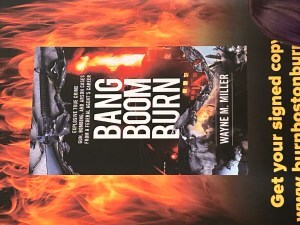
How about crime scenes? Blood spatter? Crime scene investigation? That was there.
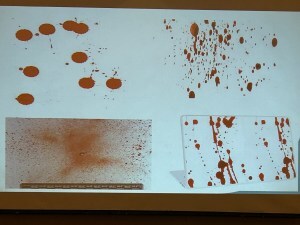
Flashwords. Lifetime Achievement. Welcoming first time authors? How about a noir-ish banquet? That was all there, too. And a whole lot of lobsters!
Our own newest member, Gabi Stiteler, was there…well, actually, everywhere since she was co-chair of the event.
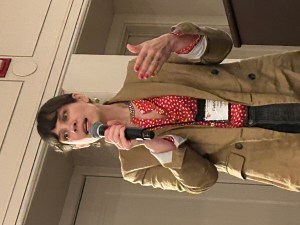
Sadly, there don’t seem to be any photos of our own Matt Cost in his crazy shorts, looking like a well-tanned boat captain who just came ashore. Maybe we will still find one of those? As for the rest of us…some of us were definitely there. Jule Selbo doing a master class.
[image error]
Kate Flora holding forth about creating tension and planting clues? This might be the world’s worst photo. But some people aren’t photogenic. At least the content was good. That red-faced critter down in the lower left is Kate.
[image error]
Dick Cass was there, as was Brenda Buchanan.


Here’s Dick’s panel:
[image error]
 Maureen Milliken was there, taking notes. And collecting books and swag for the Maine Crime Writers tree she puts together for the August Elks annual tree event. Picture a holiday tree decorated in red and green skulls or maybe a lot of black cats?
Maureen Milliken was there, taking notes. And collecting books and swag for the Maine Crime Writers tree she puts together for the August Elks annual tree event. Picture a holiday tree decorated in red and green skulls or maybe a lot of black cats?
Here, by the way, is our tree from last year:
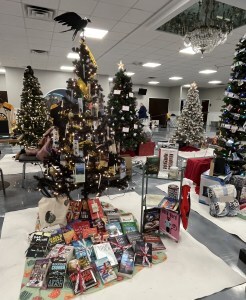
November 8, 2024
Weekend Update: November 9-10, 2024
 Next week at Maine Crime Writers there will be a report on the New England Crime Bake (Monday), and posts by Joe Souza (Tuesday), Vaughn Hardacker (Thursday), and Rob Kelley (Friday).
Next week at Maine Crime Writers there will be a report on the New England Crime Bake (Monday), and posts by Joe Souza (Tuesday), Vaughn Hardacker (Thursday), and Rob Kelley (Friday).
In the news department, here’s what’s happening with some of us who blog regularly at Maine Crime Writers:
From Kathy Lynn Emerson: Face Down Below the Banqueting House, the eighth entry in my Face Down series featuring Elizabethan gentlewoman, herbalist, and sleuth, Susanna, Lady Appleton, was released on November 7 as a newly edited trade paperback.
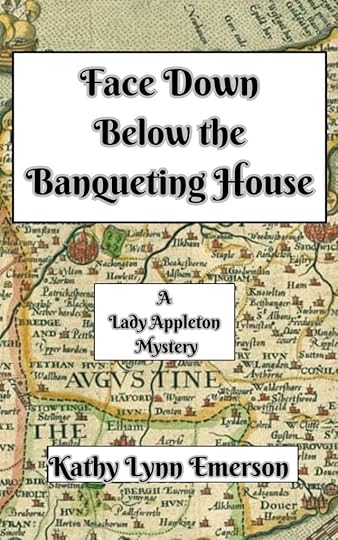
This was the first of three Face Down Mysteries published by Perseverance Press after the series was dropped by St. Martin’s Minotaur. It is included in e-book format in THE FACE DOWN COLLECTION THREE. In this one, Queen Elizabeth is threatening to pay a visit to Susanna’s home at Leigh Abbey in Kent—an expensive and nerve wracking prospect for any householder. Will murder change her mind?
Banqueting Houses were structures built, sometimes in trees, as is the case here, for the sole purpose of holding a banquet—the rough equivalent of what we’d call dessert. Kirkus said this novel is “spirited and studded with wry humor” and Booklist said “Emerson’s plot is deft and complex; she is at the top of her form here and leaves us with a breathless ending and lovely possibilities for future installments.”
Mainely Mayhem by Matt Cost pubs on Wednesday, November 13th.

Things are not right in Brunswick. Chabal is wracked by the nightmare that was the Wendigo. Langdon is hired to investigate the questionable moral integrity of one of Brunswick’s favorite sons and gets thunked in the head and left to die on a boat mooring in the Atlantic Ocean. And that is just the beginning of the bad.
Judge Cornelius Remington is being fast-tracked to be a Supreme Court Justice-why? After only a five-day investigation of Remington, Langdon is pulled from the case, suggesting that the judge had already been rubberstamped and that the White House staff and FBI were just going through the motions. But there are questions about the man’s past that Langdon can’t shake, a past that might still live in the present.
“Welcome to Maine: The Way Life Should Be.” Or so the billboard reads upon entering the state. But that was before MAYHEM, a corruption born in Brunswick that has seeped throughout the state and is threatening the entire nation.
It is up to Langdon to find and stop MAYHEM before it is too late. And the clock is ticking.
An invitation to readers of this blog: Do you have news relating to Maine, Crime, or Writing? We’d love to hear from you. Just comment below to share.
And a reminder: If your library, school, or organization is looking for a speaker, we are often available to talk about the writing process, research, where we get our ideas, and other mysteries of the business, along with the very popular “Making a Mystery” with audience participation, and “Casting Call: How We Staff Our Mysteries.” We also do programs on Zoom. Contact Kate Flora
November 7, 2024
No Appropriate Title
I got home at 9:15 Tuesday night after working 14 ½ hours as a ballot clerk here in Waterville. I woke up at 5 the next morning and swear my body temperature dropped ten degrees as I watched online reports about the outcome. The question of whether to write about it or not has been like a jai alai ball ricocheting off the inside of my skull ever since that first sip of reheated coffee.
I did my best as an involved voter including contributing the equivalent of what it would cost to rent the cottage in Perry for a week to Emily’s List candidates, writing 200 postcards to swing state voters (this year in Nevada), driving a state house candidate around so she could knock on doors (she won), and writing 120 postcards to voters in support of her candidacy.
My immediate post-election thoughts included having Barry McGuire’s prophetic song Eve Of Destruction stick in my head, particularly the following stanza:
And think of all the hate there is in Red China
Then take a look around to Selma, Alabama
Ah, you may leave here for four days in space
But when you return, it’s the same old place
The poundin’ of the drums, the pride and disgrace
You can bury your dead, but don’t leave a trace
Hate your next door neighbor but don’t forget to say grace
And you tell me
Over and over and over and over again, my friend
You don’t believe we’re on the eve of destruction
No no, you don’t believe we’re on the eve of destruction
I also am pondering and re-evaluating my opinion of the American people in general and the conclusions are NOT pretty. I’ll not share the more acerbic ones here, you can message me privately for those. However, I’m really worried for womens’ safety, along with anyone on the LGBTQIA+ spectrum, and people who aren’t lily white.
That’s all I got today, folks.

November 4, 2024
Election Day Soundtrack
The first presidential election of my life was in 1960, when John F. Kennedy was running against Richard Nixon. My working class family was comprised almost entirely of staunch Democrats, and Irish ones at that. Needless to say, in my house the soundtrack of that election was provided by the 45 rpm version of Frank Sinatra’s 1959 hit High Hopes, with the lyrics rewritten to support the Kennedy campaign:
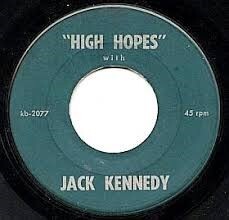
Everyone is voting for Jack
Cause he’s got what all the rest lack
Everyone wants to back – Jack
Jack is on the right track.
‘Cause he’s got high hopes
He’s got high hopes
Nineteen Sixty’s the year for his high hopes.
Come on and vote for Kennedy
Vote for Kennedy
And we’ll come out on top!
Maybe it was that buoyant song that seeded my habit of associating aspirational music with politics in general and elections in particular. By the late 1960s, I was drawn to political songs that weren’t pushing for the election of specific candidates, but advocating for change in America.
The Times They Are A-Changin’. Respect. What’s Going On.
I voted for the first time in 1976, when Jimmy Carter—who celebrated his 100th birthday last month after depositing his 2024 ballot in a courthouse dropbox near his home in Georgia—was running against Gerald Ford. I was a college sophomore, excited to be voting for the first time. Two strong memories of the experience have stuck with me.
First, the camaraderie that eased the long wait at my polling place. Strangers chatted throughout the afternoon, finding common ground of one sort or another. People took turns making food runs. If someone needed to make a phone call (no cell phones then!) or use the restroom, the rest of us held their place. The queue moved by the inch not the foot, but no one left.
The other detail I remember about that day is Simon and Garfunkel’s song America running through my head while I waited in that long, slow line, especially its coda:
They’ve all come to look for America
All come to look for America
All come to look for America
As everyone on the planet knows, today is an especially momentous election day in the United States. If you haven’t voted by the time you’re reading this, let me add my voice to those encouraging you to do so before the polls close.
This past weekend I was in Pennsylvania, which we all know is a swing state with 19 coveted electoral votes.
The song that ran through my head as we passed yard sign after yard sign after yard sign? Another memorable song from the 1960s, Sam Cooke’s A Change is Gonna Come.
As we headed home to Maine a giant, illuminated message board in the Philadelphia airport stopped me in my tracks.
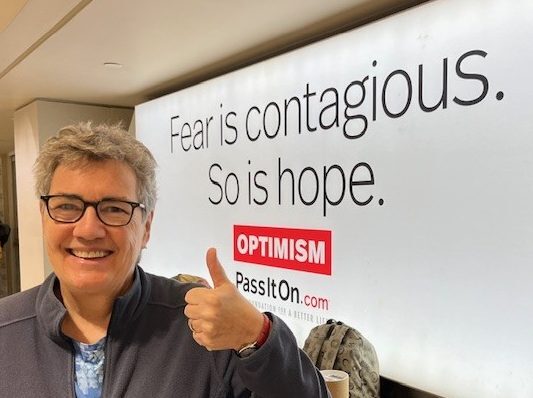
My dearest ones call me an optimist’s optimist. So what will I be humming today?
Freedom. No question about it.
Brenda Buchanan brings years of experience as a journalist and a lawyer to her crime fiction. She has published three books featuring Joe Gale, a newspaper reporter who covers the crime and courts beat. She’s now hard at work on new projects. FMI, go to http://brendabuchananwrites.com
Lea Wait's Blog
- Lea Wait's profile
- 509 followers



